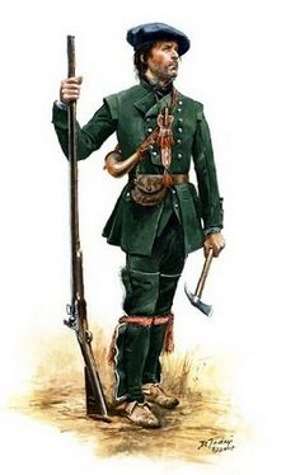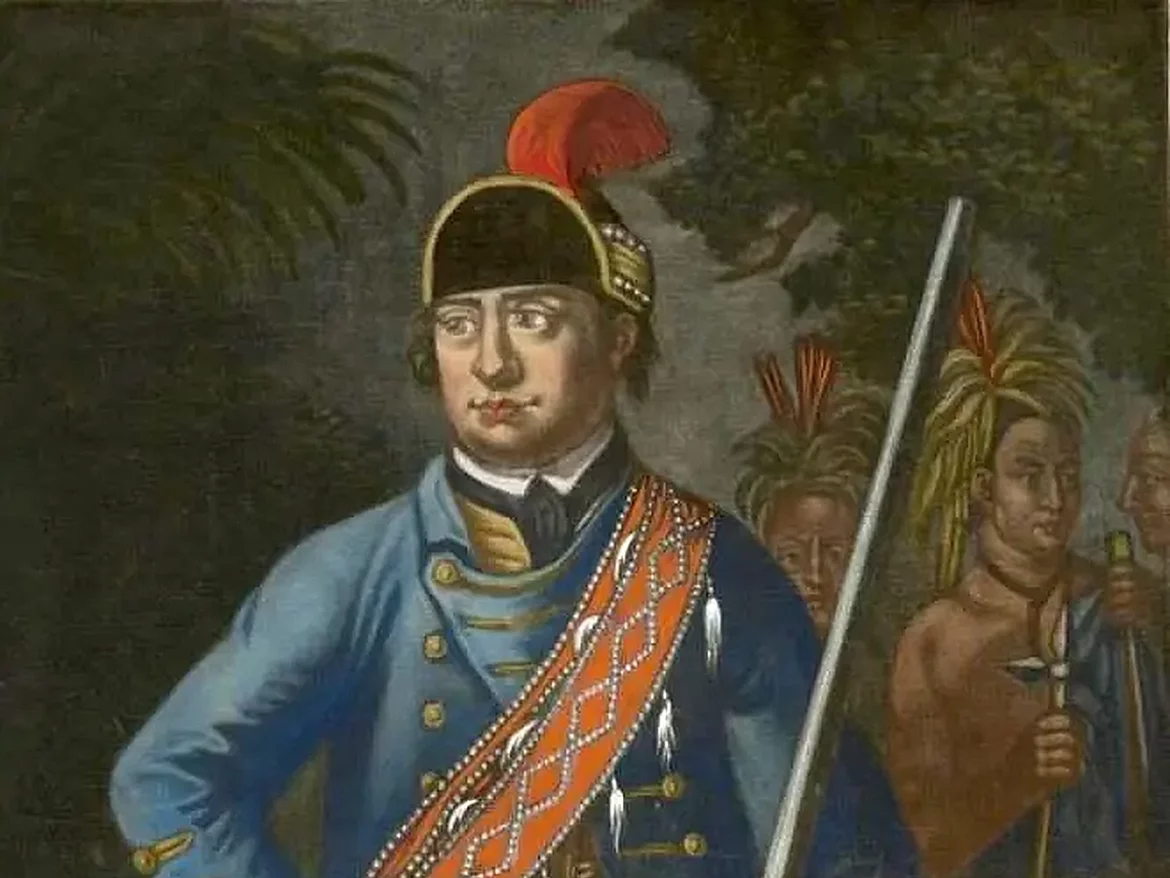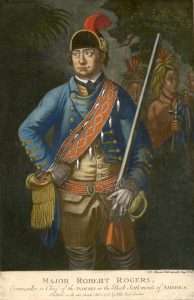More than 250 years ago, Robert Rogers wrote 28 rangers rules for guerilla warfare that are still being used by the U.S. Army Rangers.
He was a colonial frontiersman from New Hampshire who fought in the British Army during the fourth French and Indian War and the American Revolution. He commanded the Queen’s Rangers, a company of 600 men he selected himself. The British were shocked that he picked Indians and freed slaves. His unconventional tactics (for the British, anyway) were so effective the Queen’s Rangers became the chief scouting arm of the British Army in America.
And they became a legend known as Rogers’ Rangers.
Rogers’ Rangers
Robert Rogers was born Nov. 7, 1731 in Methuen, Mass., but grew up on the frontier in what is now Dunbarton, N.H.
As a teenager he fought in the third French and Indian War (also known as King George’s War), guarding the frontier from Indian raids.
He served in the New Hampshire militia in Captain Daniel Ladd’s Scouting Company and in Ebenezer Eastman’s Scouting Company. As a private he learned the essentials of guerilla warfare.
In 1755, he arrived in Portsmouth, N.H., to muster men for a light infantry company. Indians were raiding the frontier border, and Rogers found willing recruits among the frightened and angry New Hampshire men.
They wore distinctive green uniforms. Most of the time they operated in the Lake George and Lake Champlain regions of New York.
When money ran short, Rogers paid for his men’s provisions and equipment from his own pocket.
The British thought his tactics and equipment unconventional, but realized they worked. Rogers Rangers, for example, fought and won the Battle of Snowshoes – on snowshoes – in January 1757.
28 Rangers Rules
 That year on Rogers Island (named after him) he wrote the Rules of Ranging, a manual for guerilla warfare. Rogers Island was a British fortress strategically located in the Hudson River. So many troops stayed there during the French and Indian War, the only larger North American communities were New York and Boston.
That year on Rogers Island (named after him) he wrote the Rules of Ranging, a manual for guerilla warfare. Rogers Island was a British fortress strategically located in the Hudson River. So many troops stayed there during the French and Indian War, the only larger North American communities were New York and Boston.
Rogers trained his men on the island. He gave his men live fire exercises, which the British thought a waste of ammunition.
And he taught them his rangers rules. For example, men should march single file, far enough apart so one shot couldn’t go through two men.
If they reached marshy ground, they should spread out abreast so they would be hard to track.
The rangers rules dictated that men take a different route home so they wouldn’t get ambushed. They shouldn’t cross a river by a regular ford because the enemy watches them.
And they shouldn’t pass lakes too close to the water or the enemy might trap them.
After the war ended, Robert Rogers went to England to get paid for his services. He didn’t. But while there he made some money publishing his journals, A Concise Account of North America and a stage play, Ponteach [Pontiac]: or the Savages of America (1766), which portrayed American Indians in a sympathetic way.
Fact Follows Fiction
In 1937, Kenneth Roberts wrote a novel about Rogers Rangers called Northwest Passage. In it, he made up Standing Orders from the 28 rangers rules. Roberts’ version of Roger’s rangers rules is now included in the U.S. Army Ranger Handbook.
“Have your musket clean as a whistle, hatchet scoured, sixty rounds powder and ball, and be ready to march at a minute’s warning” is taken from:
“All Rangers are to be subject to the rules and articles of war; to appear at roll-call every evening, on their own parade, equipped, each with a Firelock, sixty rounds of powder and ball, and a hatchet, at which time an officer from each company is to inspect the same, to see they are in order, so as to be ready on any emergency to march at a minute’s warning; and before they are dismissed, the necessary guards are to be draughted, and scouts for the next day appointed.”
During World War II, Ranger commander Lt. Colonel William Darby read the 28 rangers rules to his troops. Today, the 75th Ranger Regiment follows an amended version of the rangers rules.
Photos: An artist in 1776 guessed what Robert Rogers looked like in his prime. It probably doesn’t look like him. Rogers Rangers from a painting by Don Troiani, via Wikipedia. This story about Roberts Rangers rules was updated in 2024.



12 comments
I’m disappointed that this article doesn’t cover more of Roberts’ misdeeds. He wasn’t a nice man, who took advantage of the military knowledge of the Native Americans who he brought into his rangers. Like so many of our so-called American heroes, he wasn’t. In 1759, he and his group went to Odanak, the home village of the Abenaki Indians in Pierreville, Quebec, Canada and massacred the innocent women, children, and elderly inhabitants, burned the town, including the Christian church that had been established by that time. He stole valuable silver from the church, shot down anyone that was seen trying to escape by running away, and made captives of those he didn’t kill. (He made a slave of 1 Abenaki boy.) At least one priest was also killed.
As a descendant of that village, I was told the oral history of that raid by my Abenaki grandmother. She said that the young men were all away on a hunting trip or other event at the time of the raid, so there were no men there to defend the village. What’s known as a “raid” by the Whites is called a “massacre” by the Abenaki. For further info on Rogers, I find this site to be useful:
http://www.seacoastnh.com/history/as-i-please/the-tarnished-tale-of-robert-rogers/
I agree my grand dad 6 back was gabreil Annance he safe his grandson and the chief was my 5 great grand dad and Robert stole my greatgrandma and ate her so yes he was no hero he was a savage
[…] As the American Revolution loomed in 1773, Wilton, N.H., was a frontier town along the Massachusetts border. It had been chartered as "Salem-Canada" in 1735 and granted to soldiers from Salem, Mass., who had served in 1690 under Sir William Phips in the first of the French and Indian wars. […]
[…] John Stark and his colonial militia began work on the Crown Point Road in 1759 during the French and Indian War. They cut down trees and removed stumps, built bridges and causeways and corduroy sections along […]
[…] business success at an early age. His political Success stemmed from his military service in the French and Indian Wars, where he fought with the likes of legendary New Hampshire general Robert Rogers. He was known as […]
[…] in 1757 and he began studying his new surroundings. He sought out the advice off New Hampshire's Robert Rogers and John Stark and Connecticut's Rufus and Israal Putnam. On a scouting mission with Robert Rogers […]
[…] experience with Indians served him well during his long military career as a bold commander of Roger's Rangers and as an inspirational battlefield leader during the American […]
[…] Stationed in New Guinea during World War II, he created a new Army Ranger unit, the 6th Ranger Battalion. […]
[…] that manuscript that James Hutson learned that none other than Robert Rogers captured Nathan […]
[…] God damn it then, Rangers, lead the […]
[…] Gray Lock, who raided English settlements in Vermont and western Massachusetts during the last French and Indian war. Or it may have been named for the gray clouds that hover at its […]
[…] But then William Pitt the Elder rose to power in England and he decided to seize as much of the French empire as he could. That included North America. So he poured men and materiel to enforce England’s claim to the territory, including Canada and the Mississippi River Basin. Robert Rogers alone commanded a unit of 600 guerilla fighters called Rogers Rangers. […]
Comments are closed.